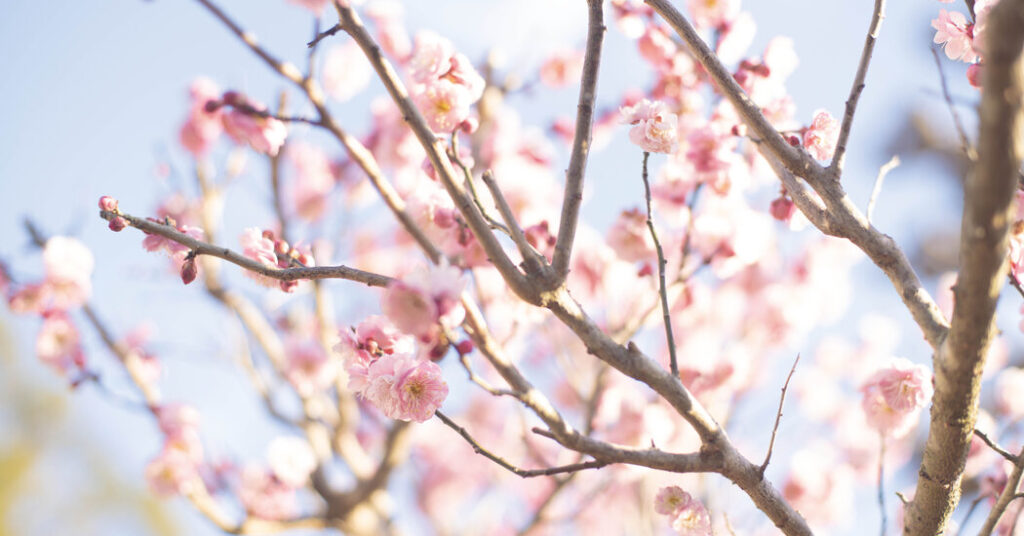The forest soon gives way to open countryside, where the only crowds are persimmon trees, arms outstretched and heavy with golden fruit. We wind through sleepy hamlets and past improvised fruit and vegetable stands in garages and aluminum-sided sheds. Some are little more than a stack of yellow plastic crates against a wall or wooden planks on cinder blocks, the goods left unattended, payment on an honor system, with handwritten prices and, in one case, a beer can on a hook to slip money into.
Persimmons are everywhere, round and squat under leafy caps, orbs the dusky yellow of marigolds or tiger orange with a sheen like a candy apple’s. One vendor hands us cut wedges as we pass, the flesh freckled, crunchy and barely sweet. The next batch, farther on, is wholly different, almost gooey, collapsing on the tongue. In someone’s driveway, we take seats alongside strangers at a picnic table and impatiently peel back the foil around yaki imo, creamy roasted sweet potatoes, then cool our singed fingers on bright chunks of persimmon, which here taste of honey and are soft without wholly surrendering structure. Our host pours us persimmon-leaf tea, mild and vegetal, and from the steam comes the fruit’s sunny scent.
As there are microseasons within each season, likewise within the life of an ingredient. Hashiri is the word for the early days, when the ingredient is still in the process of becoming and has a touch of resistance, its bite bracing and clean. (Sometimes it’s too soon, as with persimmons whose unmellowed tannins parch the mouth.) “You’re so excited in the cold of winter to see the first bamboo shoots and know that spring is coming,” says the chef Zaiyu Hasegawa, 46, acclaimed for his modern reimagining of kaiseki at Den in Tokyo. (Hatsumono is another term for this stage: literally, “first things.”) The 42-year-old chef Yoshihiro Imai, whose serene, shadow-dappled restaurant, Monk, stands off a narrow stone walk along a mossy canal in Kyoto known as the Philosopher’s Path, sees in this annual recurrence a connection to the past. “At the beginning of June, the first Kamonasu eggplant arrives,” he says, referring to a prized local variety that’s the inky purple of a bruise. “And for a thousand years, people have said the same thing: ‘Now it is summer.’”
These pioneers are typically the most expensive but, as Hasegawa notes with a smile, “not the most delicious.” That honor goes to shun, the peak, when a persimmon, for example, starts to break down and the flesh grows irresolute, ready to slouch into jam, and you can just stab in a spoon and scoop it up. Even at the end of its life, when a fruit is overripe and approaching mush, it has worth. Ayako Yuki, 59, a brand strategist for Ikigai Fruits, which last year started exporting to the United States the harvest of small Japanese farms — including crown muskmelons, grown one to a vine, the rind massaged by hand to coax out more sweetness, then boxed individually like premium whiskey and, in Japan, sold for up to 30,000 yen (around $200) a pop at luxury fruit parlors, the perfect high-end gift for your boss — thinks that the final moments of a melon might be its loveliest, the juice concentrated and deep, flagrant in its bid for flavor.
The Japanese attunement to season goes far beyond what in the West is often called farm to table — a phrase that originated in an early 20th-century American postal initiative to encourage consumers to order food directly from those who produced it. This idea was later taken up as a countercultural ethos by chefs in California in the 1970s and activists in the European Slow Food movement in the 1980s who championed ingredients anchored in time, place and the labor of independent individuals versus the global proliferation of corporate, intensively processed goods. In this context, eating what’s in season is often cast as a political choice (and a privileged position, since seasonal ingredients are typically more expensive).


AloJapan.com